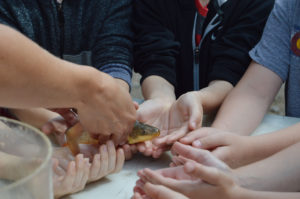Partnership Highlights Efforts to Conserve Native and Endangered Fish
“Swimming Upstream” Dives into the Upper Colorado River Endangered Fish Recovery Program
Lakewood, CO – Using data to create an illustrative and interactive digital platform, the Conservation Innovation Center collaborated with the Colorado Water Conservation Board to highlight work done by the Upper Colorado River Endangered Fish Recovery Program. Funding and support were provided by the Babbitt Center for Land and Water Policy, a center of the Lincoln Institute of Land Policy.
“Swimming Upstream” looks at the Recovery Program’s efforts to conserve native and endangered fish populations that face many challenges including invasive species and a landscape with many diverging water uses and needs.
“Our story map, ‘Swimming Upstream,’ sums it up well. The native fish species in the Upper Colorado River face many challenges from the effects of invasive species to the demands and impacts from people and industry,” said Conservation Innovation Center Geospatial Analyst Mary Molloy. “Thanks to careful planning, effective partnerships, and education the Recovery Program is seeing signs of success.”

Young students holding a razorback sucker fish. Photo Credit: Melanie Fischer, U.S. Fish and Wildlife Service
“The more people learn about where their water comes from, where it is going, and all of the life that depends on it, the more they understand water management. Successfully balancing the needs of both humans and nature in a world where water scarcity is on the rise, like we have succeeded in doing by carefully managing various flows of the Upper Colorado River, has fostered a population rise of several endangered fish species,” said Tom Chart, Director of the Upper Colorado River Endangered Fish Recovery Program.
Visitors to “Swimming Upstream” will learn about the work of the Recovery Program, a public and private partnership of water users, conservation groups, and state and federal agencies that acts as an Endangered Species Act compliance vehicle. Developed in the 1980s, the Recovery Program’s mission is to reestablish healthy populations of four endangered fish in the upper Colorado River basin using science-based, cooperative actions, while water development continues according to state, federal and tribal laws and compacts.
The Upper Colorado River Endangered Fish Recovery Program works throughout the upper Colorado River basin, but especially in the “15-Mile Reach” area described in “Swimming Upstream,” a critical area for managing the resources needed to encourage fish recovery. Flows in this 15-mile long stretch of the Colorado River would drop significantly without the strategic reservoir releases and fish ladders, screens and passages implemented by the Recovery Program and their partners.
For example, the Grand Valley and Redlands fish passages have been used for over 300,000 passages of native fish since their construction. During the exceptional drought of 2018, the flows would have dropped to zero in late September without partner voluntary coordinated reservoir releases. These science-based, cooperative mitigation actions of the Recovery Program partners have proved vital to endangered fish species recovery.
With its demonstrated successes, the Upper Colorado River Endangered Fish Recovery Program has become a national model for its collaborative conservation efforts to protect endangered species.